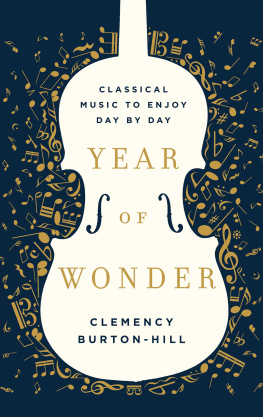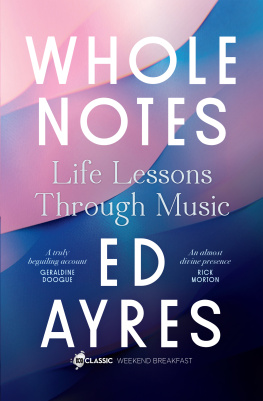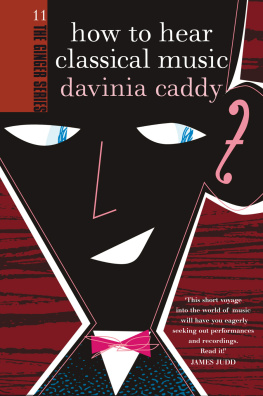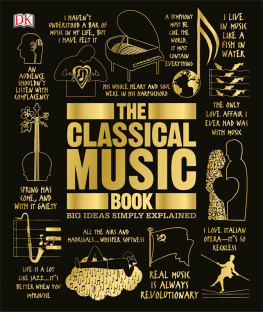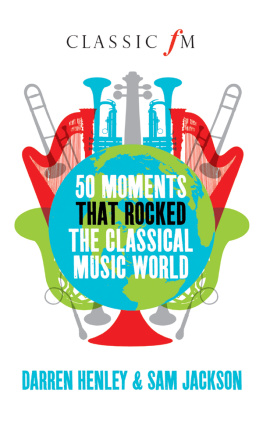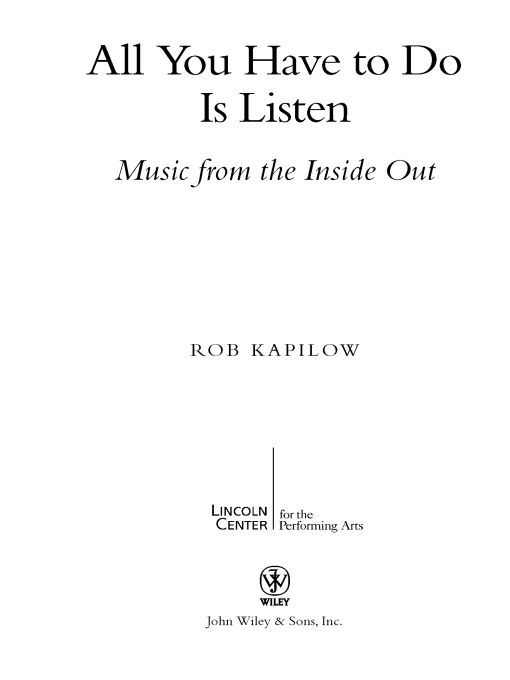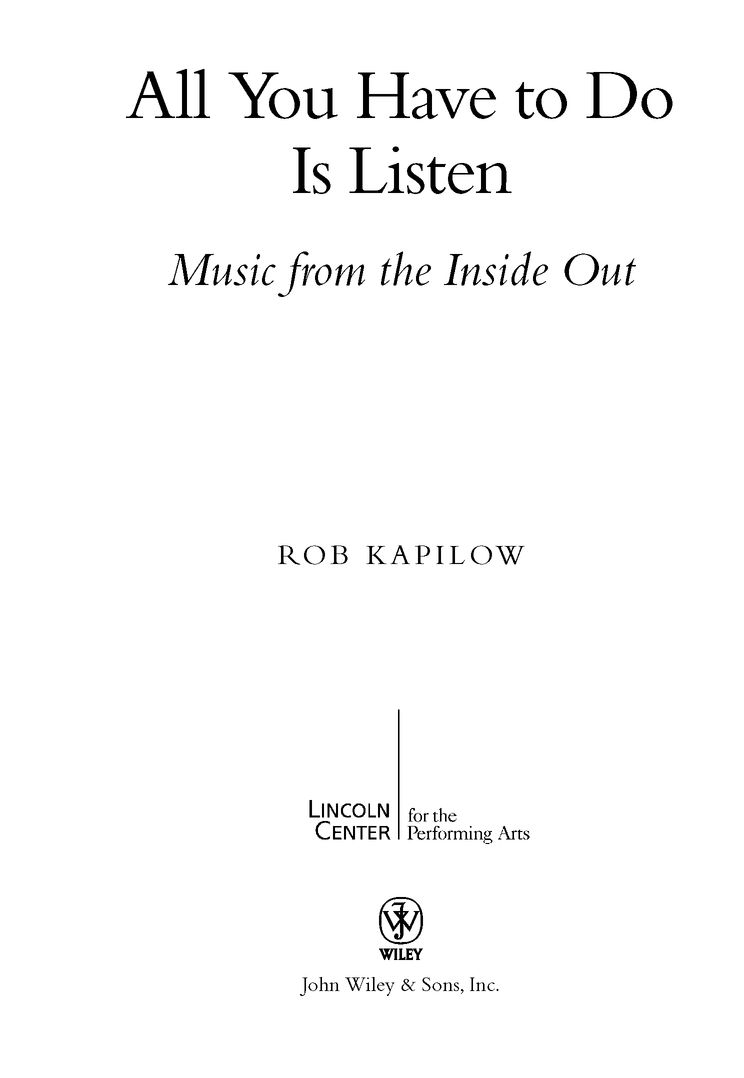Table of Contents
To the memory of Nadia Boulangerthe greatest teacher
of music and listening I have ever known
and to my wife, Claire, and my three children, Benjamin,
Sarah, and Adam: they are the music of my life.
PREFACE
Though I have spent more than twenty years trying to help listeners hear more in great music, for the first seventeen of those years, I never even considered writing a book. To write about music in any kind of meaningful detail requires that the reader be able to hear the music you are describing, and until recently this has been an obstacle faced by all books and printed materials written for the general public. Though a trained musician might be capable of looking at musical notation in a book and hearing the sound in his head, for most untrained people this is simply not possible. Consequently, in the past, a book about music either had to be so general as to be understandable without reference to the actual sounds of a piece, or if the book included detailed examples in musical notation, it largely excluded the general public without the specialized knowledge required to hear or play the examples. About ten years ago, some books began to include CDs to try to help solve the problem, but their relationship to individual examples or detailed descriptions was cumbersome and complicated and ultimately did little to solve the general listeners problem.
Recent advances in technology, however, have improved the situation, and these advances are what made me eager to write this book in the first place. When I do a live program with musicians present, I am able to take a small amount of music and work with it measure by measuretake it apart instrument by instrument, change it, highlight key details of rhythm, melody, and harmony, and then put the excerpt back together again. Now, thanks to new Web-based technology, I can do something similar in book form for all listenerswhether they can read music or not. There are ninety-three musical examples in this volume that are printed in musical notation in the book itself but are also printed on the Web site associated with this book. (See How to Use the Web Site.) All the excerpts in musical notation can be heard on the books Web site and they are designed to scroll in real time with a visual scrollbar as the music is playing. In addition, key points from the books discussion of each example are written on the musical notation on the Web site. So if the text refers to an interesting chord in measure 4, as the music plays and scrolls to measure 4, the chord will be marked in such a way that any listener can hear and see the reference whether or not he can read music. Though an experienced musician might be able to hear all of the examples simply by reading the printed notation, the Web site opens up the books musical content and discussion to any listener regardless of his musical background or training. A first-time listener might require more than one hearing of each example to fully grasp its content, but I guarantee that the repetition will be valuable.
It is my deepest hope that this new technology will allow all interested music lovers, with or without musical training, to have access to a kind of detailed musical discussion that was previously available in book form only to those with prior musical training. Though the examples might require effort and attention to master, in the end, all you have to do is listen.
ACKNOWLEDGMENTS
To write a book requires the foolhardy belief that with all that has already been written, you might still have something of value to say. Since the thought would never have occurred to me on my own, I would like to thank several key people who over my strenuous objections talked me into considering the possibility that I might be able to write something that could help listeners deepen their appreciation of music. First of all, two people at Lincoln Centerits president, Reynold Levy, and Vice President of Programming, Jane Mosswho for no apparent reason believed in this book without having the slightest idea what form it would ultimately take. At John Wiley & Sons, my editor, guiding spirit, partner, and perfect reader, Hana Lane, who was the kind of supportive yet critical taskmaster every first-time author should be lucky enough to have. My literary agent, Carl Brandt, who through three years of doubt and confusion as the project took shape was not only a willing ear for every new idea and suggestion I had, but also an unfailingly enthusiastic believer, critic, and facilitator. Louise Barder and the staff at 21C Media who were advisors, supporters, and sounding boards on every aspect of the project. My agent at IMG, Charles LeTourneau, who embodies the spirit of yes, wholeheartedly championed the project, jumping in eagerly to help make it possible even though by no stretch of the imagination should it have fallen under his purview.
I cannot give enough credit to my two superb assistants at Juilliard, Nicholas Csicsko and Alexander Popov, who spent countless hours mastering the technology at the heart of this book in order to make the musical examples spring so beautifully to life. Without their dedication, perseverance, and painstaking work, this book in its current form would not have been possible.
Perhaps most of all, however, I would like to thank the many listeners who responded to my programs either on National Public Radio, CD, or live in concert. Ultimately, it was watching and hearing their enthusiasm as they got a phrase of music, or connected with a piece for the first time, that inspired me to write this book in the first place. They convinced me that a deeper appreciation of music was not only meaningful and valuable but also utterly obtainable. They convinced me that all you have to do is listen.
HOW TO USE THE WEB SITE
To complement the text of this book, we have created a Web site where you can see and listen to the musical examples. Watch the scrollbar move along with the notes as theyre played, or download the .mp4 files to your computer.
To listen to or download the files, follow these steps:
1. Enter www.wiley.com/go/allyouhavetodoislisten into your Internet browser.
2. Click on the chapter youre looking for in the list located on the left side of the page OR click on the link labeled Download All Examples to save all the examples to a location of your choice on your computer.
3. Click on the numbered example you want to listen to.
If you want to upload the files to an .mp4-compatible portable device, such as an iPod, follow your portable devices directions on uploading an .mp4 file.
Thats all there is to it. Have fun and remember, all you have to do is listen.
PRELUDE
All You Have to Do Is Listen
Though I did not realize it at the time, the idea for this book began more than twenty years ago on the 11:20 p.m. Metro-North train from New York City to New Haven, Connecticut. Just after finishing graduate school, I was fortunate to get my first job as an assistant professor of music at Yale and the conductor of the Yale Symphony Orchestra. Toward the end of my six-year stint at Yale, I had the opportunity to conduct the Tony Award-winning musical Nine on Broadway, and for a brief period I foolishly tried to do both jobs at the same time. I would teach and conduct in New Haven during the day, race to the train, conduct the evening show on Broadway, and take the 11:20 train home after the show. The daily train ride from New York to New Haven gave me time to think about the enormous differences between the musical worlds of Broadway and Yale, and forced me to recognize some uncomfortable yet unavoidable truths.



